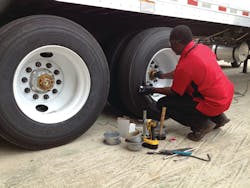Clear benefits from an effective fleet tire maintenance program
One way to understand the benefits of an effective tire maintenance program is to ask: “What are the costs of not doing so?”
In this case, the answer is simple, say Josh Carter, CEO and co-founder of Aperia, and Phillip Zaroor, president and CEO of Advantage PressurePro. Tires that are not maintained properly negatively impact fuel efficiency and tread and casing life, and can compromise safety by affecting handling and braking.
Additionally, they note that improperly inflated pressures can lead to tire failures, which can raise costs for labor and road calls, and increase downtime.
Aperia (www.aperiatech.com) is manufacturer of the Halo Tire Inflator – a self-powered, bolt-on tire inflation technology for drive and trailer axles on trucks and trailers. Advantage PressurePro (www.advantagepressurepro.com) offers tire pressure monitoring solutions (TPMS).
COST REDUCTIONS
“Research by the Federal Motor Carrier Safety Administration indicates that maintaining proper tire pressure results in a one to two percent fuel efficiency increase,” says Aperia’s Carter.
“Underinflation also reduces tire life and increases costs by 10 to 15 percent and can be responsible for tire failures,” he continues. “Numerous studies show that by eliminating tire underinflation, the average fleet can save more than $2,200 annually for each tractor trailer.”
Advantage PressurePro’s Zaroor points out that TPMS can lead to a decrease of more than 80 percent of the labor cost for checking pressures.
“When these systems are integrated with telematics solutions,” he says, “information about low and high tire pressures and high heat situations can be relayed to the fleet and acted upon proactively.”
WHEEL ASSEMBLIES
“Balancing the complete wheel assembly is also critically important,” says Coley Wolkoff, national accounts manager at Counteract Balancing Beads (www.counteractbalancing.com), an internal tire-balancing agent. “A zero out of balance condition limits vibration for a smoother ride and better handling, lowers fuel and tire costs and reduces downtime by helping prevent failure of mechanical parts and electronics.”
TECHNOLOGY
Part of the equation when adopting tire maintenance solutions is to consider the true cost of implementation.
“While an installation may seem simple and fleet technicians may have the skills to do the work effectively, managing the project is time consuming and every day that passes without the technology is a missed opportunity to realize savings,” says Deryk Powell, president of Velociti (www.velociti.com), a provider of technology deployment services. “Having the fleet’s maintenance department concentrate on keeping trucks running efficiently and employing a project management specialist can generate a much faster return on investment.”
To illustrate his point, Powell says an analysis using the Velociti ROI-Savings Calculator showed that that for a 130-unit fleet outfitted with PressurePro, anticipated savings would be about $65 per vehicle monthly in fuel and labor costs, service calls and damaged tires.
About the Author

